MY MENAGERIE EXPANDS (and a free webinar)
/2 Comments/in Gardening/by Lee ReichA Little Bit of the Mediterranean
The UPS guy arrived yesterday with a long, narrow cardboard box containing the latest addition to my menagerie, a menagerie of mostly Mediterranean plants. “Mostly” because not all of them have roots in the Mediterranean. But all of them thrive and are grown in Mediterranean climates of mild winters and sunny summers.
My collection is a “menagerie” because, although all the plants thrive and are grown in Mediterranean climates, the makeup is quite diverse. There’s the evergreen pineapple guava (Acca sellowiana that also goes under the common name feijoa), olive, rosemary, bay laurel, and Meyer lemon.
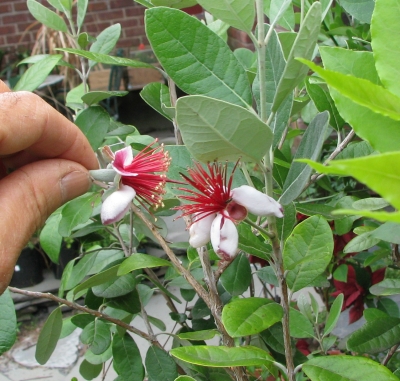
Pollinating pineapple guava
And a few of the plants — black mulberry (Morus nigra), Pakistani mulberry (Morus macroura), pomegranate, and fig — go dormant and lose their leaves in winter.
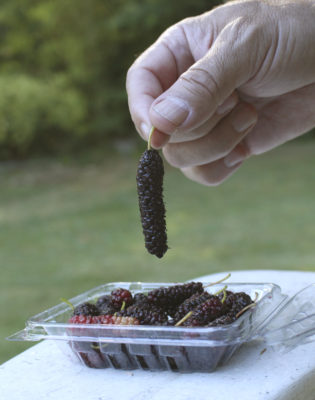
Pakistan mulberry fruit
Here at the farmden, winter temperatures can plummet to minus 20°F, so getting these plants to thrive involves more than just giving them a nice, sunny spot in the ground outdoors. Except for the figs, some of which are in the ground in the greenhouse, all the others grow in pots. Every couple of years or more, depending on the plant, I slide a potted plant out of its pot, shave off some of its roots, and then put it back into its pot with some new potting soil. Stems likewise need pruning to keep a plant from growing too big and, in the case of fruiting plants, to keep the plant fruitful.

Root pruning and repotting
Potted plants spend summers basking in sunlight, just as they would in a Mediterranean climate. Come winter, they’re protected from frigid weather but kept cool, ideally 25 to 45°F. The winter home for the deciduous plants is in the dark of either in my walk-in cooler or my cold basement. Evergreen plants need light year ‘round, which they get in various south-facing, sunny windows in cool rooms. More light allows for warmer winters indoors.
If all this sounds like a lot of trouble, it is. So why do it? I like the way the plants look but, even more so, I like the way the plants taste, especially those that bear fruit. Thus far, my most successful Mediterranean fruit has been fig; black mulberry and Meyer lemon have borne pretty well; my harvest from pineapple guava and olive have been only a few fruits each year. Still nothing from the pomegranate.
Another -Quat besides Kumquat and Sunquat
The newest addition to my menagerie is loquat (Eriobotrya japonica), bearer of plum-size yellow or orange fruits. I’ve only tasted two loquats in my life, both from fruit stands at a market (Paris and Jerusalem); neither was anything to write home about. But I know from experience the superiority of home-grown fruits. And descriptions I’ve read that loquat’s flavor combines that of apricot and peach, or that of peach, citrus, and mango. would alone would warrant my giving this plant a
try.
 I’m also attracted to loquat for its several unique features. It’s a distant relative of apple, pear, and plum, yet it flowers in autumn and the fruits ripen in spring or early summer. The leaves, large, leathery, and dark green are ornamental enough for some gardeners in equable climates to grow this plant strictly as an ornamental.
I’m also attracted to loquat for its several unique features. It’s a distant relative of apple, pear, and plum, yet it flowers in autumn and the fruits ripen in spring or early summer. The leaves, large, leathery, and dark green are ornamental enough for some gardeners in equable climates to grow this plant strictly as an ornamental. 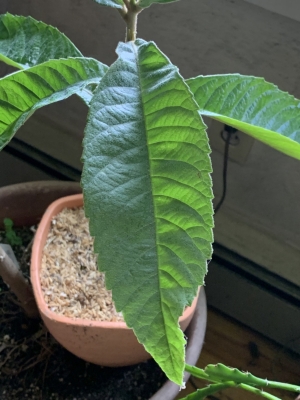 An attractive potted plant would do well to boost the eye appeal of my ragged collection of potted plants hugging sunny windows in winter.
An attractive potted plant would do well to boost the eye appeal of my ragged collection of potted plants hugging sunny windows in winter.
Loquat’s small, white flowers emit a sweet and heady aroma — another plus — and are borne in clusters at the branch tips. Good to know when it comes to pruning: if I shorten too many branches, I’ll have to say good-bye to flowers.
As an evergreen, this plant will join other Mediterranean evergreens in winter at a sunny window in a cool room. Light through even a sunny window pales compared to outdoor sunlight at the same time of year. One source says that loquat tolerates a bit of shade. That’s hopeful.
From China, Around the World, and Now Here
Loquat’s botanical roots are in China. From there, it travelled to Japan where it evidently was a hit. The Japanese have been enjoying the fruits for about 1,000 years. Now the plant is widespread in climates where it can be grown. Because the plant is a little finicky about fruiting, with 26° killing the flowers, 24° causing developing fruits to drop, 19° killing unopened flower buds, and the whole plant dying at 12°. Add to that the plants’ not liking too much summer heat or wind. No wonder commercial production of this fruit is limited.
Looking at my loquat’s leaves, I feel almost like I’m looking at an old friend, or at least a close relative of an old friend. Yes! The plant reminds me of medlar (Mespilus germanica), a cold-hardy uncommon fruit that I’ve grown and enjoyed for many years (described in my books Landscaping with Fruit and Grow Fruit Naturally, and also in my, for now. out of print Uncommon Fruits for Every Garden). Besides similar leaves, both fruit at the tips of new stems growing off one-year-old wood.
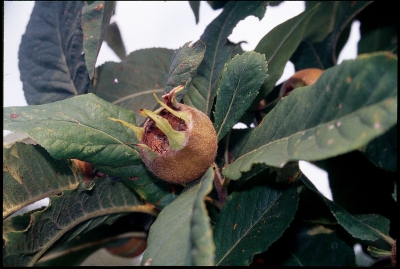
Medlar
The fruit has even been called “Japanese medlar,” and the Spanish word nispero can mean either medlar or loquat. At one time, loquat was placed in the genus Mespilus, along with medlar.
My loquat, the variety Golden Nugget, does not need a pollinator and is allegedly “juicy, firm, meaty, and sweet.” And grafted trees (mine is) bear within 2 or 3 years. So I’m hopeful. If my Golden Nugget loquat is really flavorful it will earn a place, along with four in-ground figs, in the greenhouse, where the climate is truly Mediterranean.
FREE WEBINAR ON PRUNING FRUIT TREES, SHRUBS, AND VINES!
I’ll be giving this free webinar on Saturday, April 24, 2021 from 9-10:30AM EST. Register for it at https://www.eventbrite.com/e/pruning-fruit-trees-shrubs-and-vines-tickets-149851978301
FRUITFUL FUTURES
/10 Comments/in Fruit/by Lee ReichMaking the Best of It
Eek! Mice (or rabbits)! Not the animals but the damage they have wrought. The bark on virtually all my pear grafts of last year has been nibbled off enough to kill the grafts.
Once I calmed down, I realized that all was not lost. All the chewing was above ground level, leaving a small amount of intact bark still in place. The plants aren’t dead, just their portions above the chewing. The near-ground portions could be grafted again.
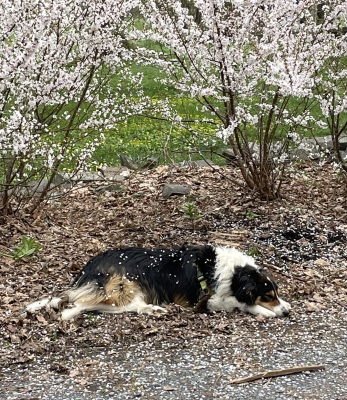
Daisy showered with petals (more on this later)
(Most fruit trees neither come true from seed nor root readily from cuttings, so are propagated by grafting a scion — a short length of one-year-old stem — of the desired variety onto a rootstock. The rootstock is the same kind of plant as the scion variety and could be a seedling or a variety developed for special rootstock purposes. My nibbled trees are pear trees, Highland, Blake’s Pride, and other varieties, each grafted on a rootstock named Old Home X Farmingdale 87, which dwarfs the trees’ final height to about half that of a full-size pear tree, as well as induces it to yield its first fruits sooner.)
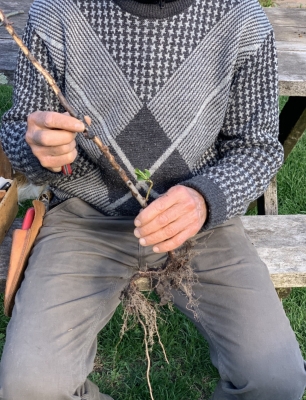
Damaged rootstock
Crouched way down at ground level would be a tough position for grafting, not to mention trying to keep dirt and debris off the cut surfaces. So I dug up each plant for “bench grafting,” so named because it’s done at a bench or, more generally, upright and in the comfort and better light of indoors.
My graft of choice for these wounded plants is the whip graft. It’s a simple graft, especially for apple and pear; I typically expect 95+ percent “takes.” With a well-honed, preferably straight-edged (and preferably single-bevelled) knife, I make a smooth, sloping cut about 3/4-inch long on the rootstock. Typically, I would make the cut longer but there’s not that much viable stem above-ground.

Making the cuts on rootstock and scion
Next, I take a scion of similar thickness to the rootstock, although this is not all-important, and make a similarly smooth, sloping 3/4-inch long cut.
If the cuts are secured face to face and then sealed against moisture loss, cells at the cuts start to multiply, eventually knitting the two pieces together and joining their vascular tissue. If the two plant pieces are not matching in thickness, success can still be achieved if just one side of the two of them is aligned. A piece of rubber, either a cut open rubber band or a bona fide grafting rubber, keeps cut edges of scion and rootstock intimate, and then the wound is sealed with Tree-Kote or similar tree wound material, or Parafilm tape.



Sealing the graft with Parafilm
Keeping the roots moist and the plants indoors for a couple of weeks speeds growth of new cells. After that, the plants will go outdoors, either potted up or planted in the ground.
The Downside to Low Grafting
Grafting so low on the plant does have its downsides. For one thing, a certain amount of rootstock stem above ground level is needed for the dwarfing effect. For full effect, grafts are usually made 6 to 12 inches above ground level.
Also, if a graft is very low on a plant so that over the years it gets covered with soil, the scion is could eventually root. At which point the dwarfing and other benefits of the rootstock are lost.
On the plus side, if any of my grafts fail, the still viable rootstock will undoubtedly send up a new shoot, which can be grafted next spring — and done well above ground level.
So How Do You Get a Rootstock?
The way to get a rootstock is to buy one (ha, ha). But how does as nursery make, for instance, an Old Home X Farmingdale 87 pear rootstock if pears (and most other tree fruits) are so hard to root and don’t come true from seed.
Rootstocks are bred or selected to impart special characteristics to the tree for which they provide roots and a short length of stem — very short stems in the case of this week’s pear grafts. Another characteristic that might be sought in a rootstock is ease of propagation, perhaps even by cuttings.
Whereas a pear variety such as Blake’s Pride is propagated from mature, fruiting wood, a rootstock might be propagated from juvenile wood, that is, wood that that has never grow to maturity. All plants are easier to multiply from juvenile wood. Near the base of a plant that has been raised from seed, the wood retains its juvenility, so a seed-propagated rootstock variety that was repeatedly cut back would provide stems that were juvenile and could be rooted as cuttings.
And there are other ways to coax new plants from an existing plant, such as tissue culture and stool layering. Maybe something about these methods at another time.
Fruitful Near Futures
Even grafted higher atop a rootstock that imparts precocity, my pear grafts aren’t apt to yield their first crop for a few years. My Nanking cherry bushes (Prunus tomentosa), on the other hand, are slated to have bright red cherries arching their stems to the ground in a couple of months or so.
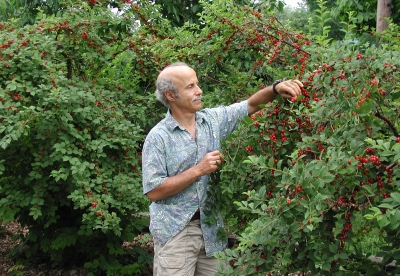
The cherries are small, but are very juicy with a refreshing flavor that combines that of sweet and tart cherries. Another plus for these plants is that they are more or less free of pest problems, requiring no care on my part beyond picking the fruit. Read more about them in my book Landscaping with Fruit.
No need to ignore the bushes until payday because payday is also right now, visually. Along the length of my driveway, the hedge of Nanking cherries has turned into a cloud of dense, slightly pink, white flowers. This time of year it’s not uncommon for a biker or walker to stop and ask the name of the plants. “Nanking cherry!”

Nanking cherry hedge
TRANSPLANT GROWING, A BETTER WAY
/22 Comments/in Vegetables/by Lee ReichSnicker if You Will
I don’t know about your propagation space, but mine is getting overcrowded. Yes, now with a greenhouse, I’ve got more room than in the the past when I grew seedlings in windowsills or in my basement under lights. But my greenhouse is small, and with greenhouse beds home to fig trees and early spring lettuce, arugula, and other greenery, seedlings are relegated to a 12 by 2 foot shelf along the north wall.
I make the most of that shelf by “pricking out.” Snicker if you will at this Britishism, but pricking out is a way to get a lot of bang for your buck space-wise, whether in a greenhouse, on a windowsill, or beneath lights. It also makes more economical use of seeds.
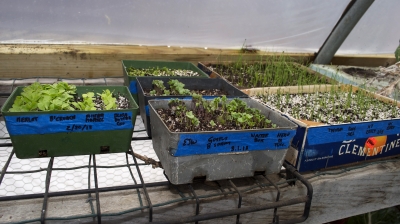
The process begins, for me, with either 4 by 6 inch or 6 by 8 inch seed flats, which are plastic pans a couple of inches deep with drainage hole drilled in their bottoms. I fill one of these with potting soil, firm it, and then treat it like a miniature farm field, making 4 or 5 furrows along the short length. I press these furrows into the potting soil with a board that fits the flat to the underside of which I attached dowels where I wanted the furrows.
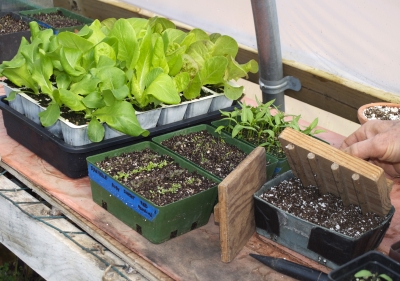
The first cool thing about this whole process is that each furrow can be sown to a different variety. I generally sow the flat to different varieties of the same kind of plant so that germination of the whole flat is fairly uniform. Looking over at one of my larger flats, I see newly emerged sprouts of Nepal, Belgian Giant, Paul Robeson, Amish Paste, and Blue Beech tomatoes. All taking up a mere 48 square inches!
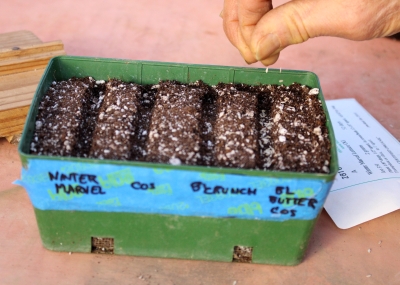
Flats of tomato seed were planted April 1st, watered, and kept warm, and those sprouts emerged today, the 6th. No light is needed until sprouts emerge. After a week , now with good light, those cotyledons (seed leaves) will darken and true leaves will appear. That’s when it’s time to actually “prick out.” Mind you, for two weeks, all those potential tomato plants have been getting started in a mere 48 square inches, the first week of which they didn’t even need light!

Other kinds of seeds take longer to germinate. Or shorter. And temperature also figures in. Tables of optimum germination temperatures for various kinds of seeds are available on the web and in some seed catalogs.
The Process
Pricking out is transferring the still tiny seedlings from the seed flat to individual cells to “grow on,” another Britishism. For these containers I’ve used saved cell-packs from plants I’ve bought in the past; now I mostly use Growease Seed Starters automatic watering system from gardeners.com. Depending on how many plants you’ll be growing and what you’ve got, small yogurt containers, even jumbo egg cartons could also fill the bill.

To start, I take a dibble, for this use, a pointed plastic cylinder about 3/4 inch across, and make a hole in one potting-mix-filled cell. (Etymologically, “dibble” originally was, or is, Manchester British slang for a police officer, from a character in a cartoon. How did that become the name for the black plastic thing I’m holding?)
Back to the seed flat . . . time to lift individual seedlings out of their seed flat and into their newly dibbled hole. Those seedlings are very delicate and will die if the stem is injured. So I take a knife or a spatula and scoop up underneath a clump of seedlings to loosen the potting soil around their roots, and then take gentle hold of one of their leaves to lift the plantlet free.
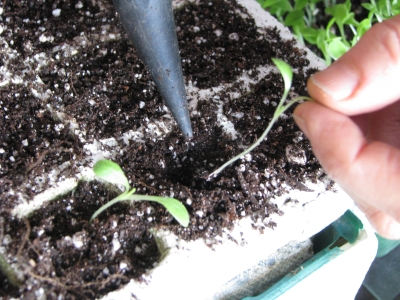
After lowering one plant’s roots into its waiting hole, I firm the potting soil around the roots. No, not pressing against the stem, which could injure it, but pressing down into the potting soil. And not too hard. Just enough to firm it around the roots. One advantage of pricking out is that you can set the little seedling deep in the hole, up to its true leaves, so that the leaves are no longer supported by the weak, young stem.
Water is needed right away, either from below by sitting the container in a pan of water for awhile, or with a gentle shower from above. The newly planted seedlings are not turgid for a few hours so water from above often accumulates on the leaves to weigh down the plant. The wet leaves, flopped down on wet potting soil, are apt to rot, so with my finger I go plant by plant flicking off the water, and then the plants stand up straight.
After about 5 more weeks of growth with bright light and slightly cooler temperatures, the plants will be sturdy and the season will be ripe for tomato planting. Sometimes I caress my plants to encourage stocky growth, raking my hand gently over their tops, ideally once a day. The effect, called thigmotropism, is the same as that which causes dwarf, stocky growth of pine trees on wind mountain outcroppings.
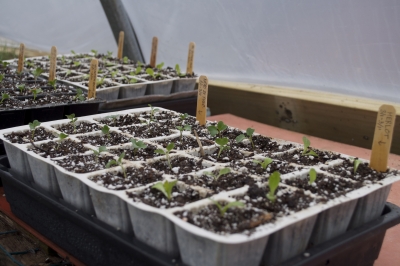
Not all seedlings follow tomato’s schedule. Celery, for instance, might take 3 weeks to germinate and then another 9 weeks to grow to transplant size. (For details on when to sow, based on the average date of the last spring frost where you garden, see the vegetable section of my book Weedless Gardening.)
Followup on Previous Weeks’ Blogs
My first batch of birch syrup from a couple of weeks ago was, according to a friend who boiled it down for me, awful. “Worst thing I ever tasted,” says he.
But some of that syrup was cloudy from microbial activity during the warm weather. That could have caused that distinctive flavor.
Colder weather followed, and I tried again, discarding any cloudy sap. Boiled into a syrup, the flavor was still distinctive, not awful, but also not really good. Something reminiscent of cough syrup or molasses. The sap is high in fructose, which burns at a lower temperature than sucrose, the primary sugar in maple sap. It more easily takes on a scorched flavor, which my syrup definitely has, in excess.
Perhaps a species other than river birch would have been better, even good. The syrup is usually made from paper birch. All I grow here is river birch, though. They are, at least, beautiful trees.
And a followup on my overwintered artichoke plants. Or, I should write, my non-overwintered artichoke plants. Perhaps something will eventually emerge. No sign of anything yet, and I’m not hopeful.

